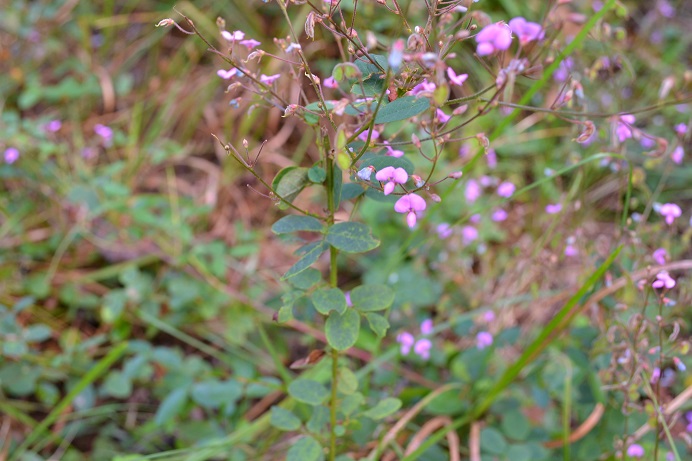Difference between revisions of "Desmodium ciliare"
| Line 34: | Line 34: | ||
''D. ciliare'' is found in fields, woodland borders, and disturbed areas. <ref name= "Weakley 2015"> Weakley, A. S. (2015). Flora of the Southern and Mid-Atlantic States. Chapel Hill, NC, University of North Carolina Herbarium. </ref> | ''D. ciliare'' is found in fields, woodland borders, and disturbed areas. <ref name= "Weakley 2015"> Weakley, A. S. (2015). Flora of the Southern and Mid-Atlantic States. Chapel Hill, NC, University of North Carolina Herbarium. </ref> | ||
===Phenology=== <!--Timing off flowering, fruiting, seed dispersal, and environmental triggers. Cite PanFlora website if appropriate: http://www.gilnelson.com/PanFlora/ --> | ===Phenology=== <!--Timing off flowering, fruiting, seed dispersal, and environmental triggers. Cite PanFlora website if appropriate: http://www.gilnelson.com/PanFlora/ --> | ||
| − | ''D. ciliare'' flowers September-November. <ref name= "PanFlora"> PanFlora Author: Gil Nelson URL: [http://www.gilnelson.com/PanFlora/ http://www.gilnelson.com/PanFlora/] Date Accessed: 5/21/18 </ref> | + | ''D. ciliare'' flowers September-November. <ref name= "PanFlora"> PanFlora Author: Gil Nelson URL: [http://www.gilnelson.com/PanFlora/ http://www.gilnelson.com/PanFlora/] Date Accessed: 5/21/18 </ref> Leaves alternate, pinnately trifoliolate compound; leaflets usually 3, usually ovate-oblong or elliptic, larger ones usually less than 1.2 inches long, slightly rough to touch, stipels present; fruit is 1-3 jointed loment, margins densely covered with short, hooked hairs, surfaces moderately so. <ref name= "Gee 1994"> Gee, K. L., et al. (1994). White-tailed deer: their foods and management in the cross timbers. Ardmore, OK, Samuel Roberts Noble Foundation. </ref> |
<!--===Seed dispersal===--> | <!--===Seed dispersal===--> | ||
<!--===Seed bank and germination===--> | <!--===Seed bank and germination===--> | ||
Revision as of 19:36, 12 June 2018
Common name: hairy small-leaf ticktrefoil [1]
| Desmodium ciliare | |
|---|---|

| |
| Photo by | |
| Scientific classification | |
| Kingdom: | Plantae |
| Division: | Magnoliophyta - Flowering plants |
| Class: | Magnoliopsida - Dicots |
| Order: | Fabales |
| Family: | Fabaceae |
| Genus: | Desmodium |
| Species: | D. ciliare |
| Binomial name | |
| Desmodium ciliare Muhl | |

| |
| Natural range of Desmodium ciliare from USDA NRCS Plants Database. | |
Contents
Taxonomic Notes
Synonyms: D. ciliare var. ciliare; D. ciliare var. lancifolium Fernald; Meibomia ciliaris (Muhlenberg ex Willdenow) Blake
Varieties: none
Description
D. ciliare is a perennial forb/herb of the Fabaceae family native to North America and Canada. [1]
Distribution
D. ciliare can be found along the southeastern coast of the United States from Texas to Massachusetts, as well as the Ontario region of Canada. [1]
Ecology
Habitat
D. ciliare is found in fields, woodland borders, and disturbed areas. [2]
Phenology
D. ciliare flowers September-November. [3] Leaves alternate, pinnately trifoliolate compound; leaflets usually 3, usually ovate-oblong or elliptic, larger ones usually less than 1.2 inches long, slightly rough to touch, stipels present; fruit is 1-3 jointed loment, margins densely covered with short, hooked hairs, surfaces moderately so. [4]
Conservation and Management
D. ciliare is listed as threatened by the New York Department of Environmental Conservation Division of Land and Forests, and by the Rhode Island Department of Environmental Management. [1]
Cultivation and restoration
Photo Gallery
References and notes
- ↑ 1.0 1.1 1.2 1.3 USDA Plant Database https://plants.usda.gov/core/profile?symbol=DECI
- ↑ Weakley, A. S. (2015). Flora of the Southern and Mid-Atlantic States. Chapel Hill, NC, University of North Carolina Herbarium.
- ↑ PanFlora Author: Gil Nelson URL: http://www.gilnelson.com/PanFlora/ Date Accessed: 5/21/18
- ↑ Gee, K. L., et al. (1994). White-tailed deer: their foods and management in the cross timbers. Ardmore, OK, Samuel Roberts Noble Foundation.